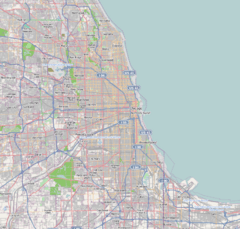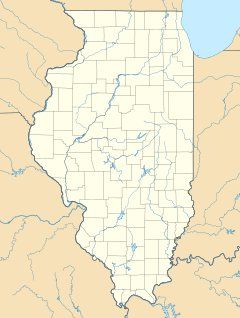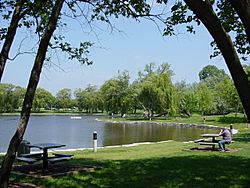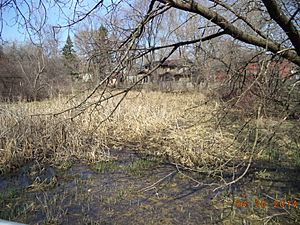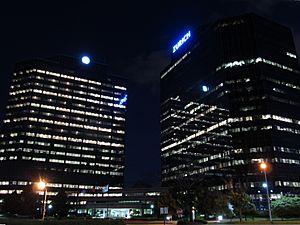Schaumburg, Illinois facts for kids
Quick facts for kids
Schaumburg, Illinois
|
||
|---|---|---|
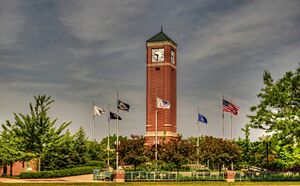
Veterans Gateway Park
|
||
|
||
| Motto(s):
"Progress Through Thoughtful Planning"
|
||
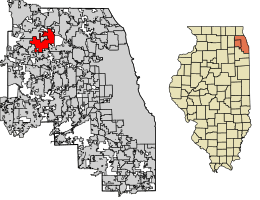
Location of Schaumburg in Cook and DuPage Counties, Illinois
|
||
| Country | United States | |
| State | Illinois | |
| Counties | Cook and DuPage | |
| Townships | Schaumburg, Palatine, Hanover | |
| Incorporated | March 7, 1956 | |
| Government | ||
| • Type | Council–manager | |
| Area | ||
| • Total | 19.46 sq mi (50.42 km2) | |
| • Land | 19.35 sq mi (50.11 km2) | |
| • Water | 0.12 sq mi (0.31 km2) 22% | |
| Area rank | 9 | |
| Elevation | 794 ft (242 m) | |
| Population
(2020)
|
||
| • Total | 78,723 | |
| • Density | 4,069.21/sq mi (1,571.12/km2) | |
| Demonym(s) | Schaums | |
| Time zone | UTC−6 (CST) | |
| • Summer (DST) | UTC−5 (CDT) | |
| ZIP Code(s) |
60159, 60168, 60173, 60179, 60193-60196
|
|
| Area code(s) | 847/224 and 630/331 | |
| FIPS code | 17-68003 | |
| Wikimedia Commons | Schaumburg, Illinois | |
Schaumburg (pronounced SHAWM-burg) is a village in Cook and DuPage counties in the U.S. state of Illinois. In 2020, its population was 78,723. This makes Schaumburg the most populated village in the United States. It is about 28 miles (45 km) northwest of Chicago Loop and 10 miles (16 km) northwest of O'Hare International Airport. Schaumburg is part of an important business area called the Golden Corridor.
Schaumburg changed from a farming community to a busy suburban city. This change began in 1959 with new housing developments. It grew even more when Woodfield Mall opened in 1971. Schaumburg is surrounded by other towns. These include Hoffman Estates and Palatine to the north, and Elk Grove Village to the southeast.
Contents
History of Schaumburg Village
Early Settlers and German Roots
The village of Schaumburg was officially created on March 7, 1956. But its history goes back much further. The first people to live here were Native American tribes. These included the Sauk, Meskwaki, Potawatomi, and Kickapoo peoples.
In the mid-1800s, new settlers started to arrive. Many came from Bonn, Germany, especially from a small state called Schaumburg-Lippe. Others came from the eastern United States.
One early settler was Johann Sunderlage, who was German-born. Legend says he liked the area so much while working on a survey team that he brought his family and friends from Germany to settle here around 1836. His original home still stands today.
At first, about half of the households were from the eastern U.S. and about a quarter were German. But by the 1850s, more Germans had moved in. By 1870, almost all the land in Schaumburg Township was owned by German immigrants or their families. Many settlers from the eastern U.S. moved further west.
German heritage was very important in the area for a long time. German was the main language in most homes until the 1950s. St. Peter Lutheran Church, the oldest Christian church in the community, held services in German until 1970. The church building is now a museum.
How Schaumburg Got Its Name
The area was first called Sarah's Grove in 1842. This was because three families living near a grove of woods each had a woman named Sarah.
In 1850, citizens met to choose a new name for the town. A wealthy landowner named Friedrich Heinrich Nerge reportedly yelled, "Schaumburg schall et heiten!" This means "It will be called Schaumburg!" in Low German. And so, the township officially became Schaumburg.
The name came from Schaumburg County in Germany. Most German settlers in the area were from there.
Farming and Growth in the 19th Century
In its early days, Schaumburg Township was a successful farming area. People grew potatoes, raised dairy cows, and kept cattle. The land was mostly a large meadow with lots of wildlife.
By 1858, a small market center formed at what is now Schaumburg and Roselle roads. This area, called Schaumburg Center, had stores, cheese factories, and workshops.
Schaumburg was quite isolated back then. There were few roads, and they were often hard to use. Farmers had to travel 27 miles (43 km) to Chicago by wagon to sell their goods.
Changes in the 20th Century
By 1900, Schaumburg was known as a great community. A brochure from that time said it was a "model community" with good roads, churches, and schools. It also proudly mentioned that Schaumburg "has never had a jail."
In 1925, O. D. Jennings, who made slot machines, bought a house in the village. After his death, his wife donated the house and land to the village. It became the Village Hall until 1971.
Schaumburg's isolation ended when cars became popular. Also, O'Hare International Airport opened nearby in 1955. The Northwest Tollway was built through the farmlands in 1956. These changes brought more people and businesses to the area.
To manage this growth, the village of Schaumburg was officially created in 1956. It started with a population of 130 people and covered two square miles. Early leaders planned carefully. They set aside large areas for businesses and offices. This helped Schaumburg become a major employer and a big shopping center.
During the 1960s, Schaumburg grew a lot. It was no longer a quiet farming town. In 1959, Alfred Campanelli started building Weathersfield, a large neighborhood with thousands of homes. He built over 6,800 homes in Schaumburg. The village's YMCA is named after him.
In 1967, the first apartment complex, International Village, was built. The next year, Motorola started building its main office nearby.
From 1969 to 1975, country singer Bob Atcher was the village president.
The growth continued into the 1970s. By 1970, the population was 18,730. Another expressway, Interstate 290, opened in 1970. This made it easier to get to Chicago. In 1971, Woodfield Mall opened. This led to huge growth in businesses, factories, and homes.
In 1978, the village created the Olde Schaumburg Centre Overlay District. This was to protect the historic feel of the area around Schaumburg and Roselle roads.
By 1980, Schaumburg had grown to 18.3 square miles (47.4 km2) and had 53,305 residents. In the 1980s, many large office buildings were built near Woodfield Mall. Also, many small factories and warehouses opened. Schaumburg became known as an "edge city" – a place with lots of jobs outside a traditional downtown.
By 1990, Schaumburg's population was 68,586. Growth slowed as there was less land for new homes. Office building also slowed down. However, shopping areas continued to grow. One Schaumburg Place and Village Green were built. Woodfield Mall was also redesigned and expanded. It became a major tourist spot, attracting visitors from all over the world. IKEA, a big furniture store, opened a large store near Woodfield in the late 1990s.
In 1994, the village bought the Schaumburg Regional Airport. Most of the money for this came from federal and state grants.
In 1995, the village bought the Town Square shopping center. They rebuilt it into a new downtown area. It now has stores, the Schaumburg Township District Library, offices, and a public outdoor theater. The Trickster Gallery, a museum about Native American heritage, is also there.
In 1999, minor league baseball came to Schaumburg. Alexian Field, a 7,000-seat stadium, was built. It was home to the Schaumburg Flyers. In 2012, the stadium became home to the Frontier League's Schaumburg Boomers and was renamed Boomers Stadium.
Schaumburg in the 21st Century
In 2000, the village bought 45 acres (18 ha) of land. This land was developed into the Renaissance Schaumburg Hotel & Convention Center.
Geography of Schaumburg
Schaumburg is located at 42°01′49″N 88°05′02″W.
The village covers about 19.47 square miles (50.42 km2). Most of this is land, with a small amount of water. The elevation ranges from 750 to 850 feet (229 to 259 m) above sea level. The highest point is at the intersection of Schaumburg Road and Webster Lane.
Schaumburg is where the West Branch Dupage River begins. This river flows southwest. The West Branch of the Salt Creek also flows through the eastern part of the village, going east into Busse Lake.
Population and People
| Historical population | |||
|---|---|---|---|
| Census | Pop. | %± | |
| 1960 | 986 | — | |
| 1970 | 18,724 | 1,799.0% | |
| 1980 | 53,305 | 184.7% | |
| 1990 | 68,586 | 28.7% | |
| 2000 | 75,386 | 9.9% | |
| 2010 | 74,227 | −1.5% | |
| 2020 | 78,723 | 6.1% | |
| U.S. Decennial Census 2010 2020 |
|||
In 2020, Schaumburg had 78,723 people living in 30,249 households. About 30% of households had children under 18. The average household size was 3.15 people.
The population includes people from many different backgrounds. In 2020, about 57.55% of residents were White, 4.28% African American, and 26.46% Asian. About 10.50% of the population was Hispanic or Latino.
The median age in Schaumburg was 38.5 years. This means half the people were younger and half were older.
The median income for a household was $82,387. For families, it was $98,640. About 5.7% of the population lived below the poverty line.
Economy and Jobs
Schaumburg is home to the main offices of several companies. These include Zurich North America and Perdoceo Education Corporation. Many Japanese companies also have their U.S. headquarters here.
Major Employers in Schaumburg
The biggest employers in Schaumburg are:
- Woodfield Mall (4,400 employees)
- Zurich North America (2,600 employees)
- Community Consolidated School District 54 (2,030 employees)
- Motorola Solutions (1,600 employees)
- OptumRx (Catamaran) (1,300 employees)
- IBM (900 employees)
- Genworth Financial (850 employees)
- Paylocity (800 employees)
- Nation Pizza and Foods (700 employees)
- Encore Village (650 employees)
Getting Around Schaumburg
Schaumburg has a train station on Metra's Milwaukee District West Line. This line connects Schaumburg to Elgin and Chicago Union Station.
The Schaumburg Regional Airport is a small airport for private planes. It is located near Irving Park Road and Roselle Road.
Pace buses also serve Schaumburg. Local and express buses stop at the Northwest Transportation Center near Woodfield Mall. From there, you can connect to the Rosemont Transportation Center. This allows you to take the Blue Line train into Chicago. Pace also offers a special "dial-a-ride" bus service. You need to book this service in advance.
Schools and Learning
Public schools in Schaumburg get their money from property taxes.
The main public school district is Community Consolidated School District 54. Many of its elementary schools have won awards. These include the Blue Ribbon Awards. The schools also offer special education and dual language classes. They have programs for gifted students too.
Schaumburg is part of Township High School District 211. This district has five high schools: Schaumburg High School, Hoffman Estates High School, Conant High School, Fremd High School, and Palatine High School. Schaumburg High School recently added new classrooms and science labs.
There are also several private and religious schools in Schaumburg. Some examples are Schaumburg Christian School and St. Peter Lutheran School.
Universities and Colleges
Schaumburg has several places for higher education:
- Roosevelt University has a campus in Schaumburg. It is the largest four-year university in Chicago's Northwest suburbs. About 2,500 students attend classes there. The campus is in the old headquarters of the Pure Oil Company. Roosevelt offers a Doctor of Pharmacy program. It also has a PhD program in Industrial-Organizational Psychology.
- Other schools include The Illinois Institute of Art – Schaumburg campus and American InterContinental University.
Schaumburg Public Library
The Schaumburg Township District Library has a main branch in Schaumburg. It also has two smaller branches in Hanover Park and Hoffman Estates. The library has over 560,000 items.
It is one of the largest libraries in the country. It has many meeting rooms and a high-tech Teen Place for ages 12–19. There's also a kidsZone with activities and play space. The library offers programs all year, like book discussions and technology classes. It even has a drive-up window for easy pick-up and drop-off of materials.
Famous People from Schaumburg
Some notable people who have lived in Schaumburg include:
- Susan Downey (née Levin), a film producer and wife of actor Robert Downey Jr.. She was the valedictorian of Schaumburg High School in 1991.
- Kurt Kittner, a former NFL quarterback for the Chicago Bears.
- Shane Madej, an internet personality known for Buzzfeed Unsolved.
- Chris Mueller, a soccer player for Chicago Fire FC and the United States national team.
Parks and Nature
In 2017, the Schaumburg Park District opened Bison's Bluff Nature Playground. This playground is part of the Spring Valley Nature Center & Heritage Farm. It is designed to help children connect with nature. The play area uses natural materials like logs, boulders, and sand. It also has features that look like rock bluffs and flowing streams.
The goal of Bison's Bluff is to encourage kids to be active. It helps them develop skills like agility and problem-solving. It also teaches them about cooperation and trying new things.
See also
 In Spanish: Schaumburg (Illinois) para niños
In Spanish: Schaumburg (Illinois) para niños



